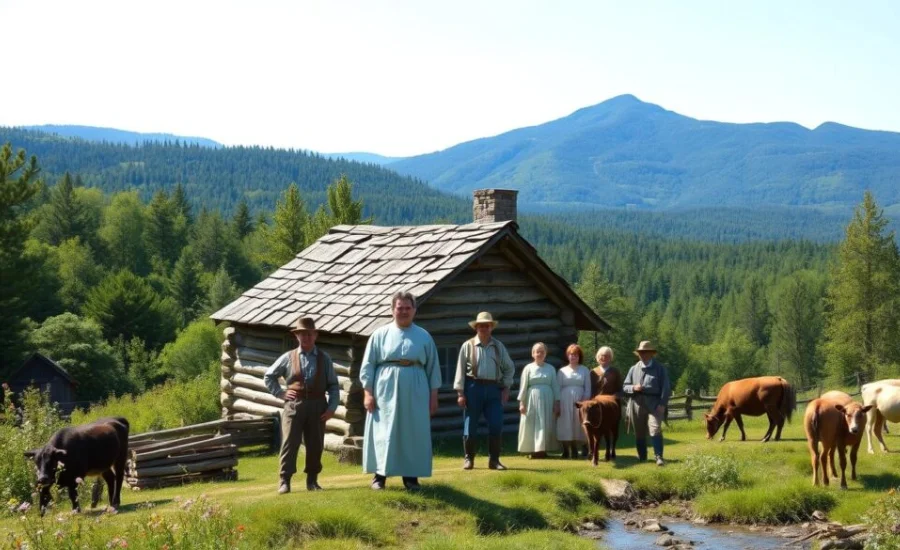A History of Stewart Peak Warner NH site with profound cultural and environmental value is Stewart Peak in Warner, New Hampshire. Its history stems from the customs of native peoples who considered the summit to be a sacred location as well as an essential natural resource. In addition to providing vital sustenance due to its abundant biodiversity, the area’s tranquil setting served as a venue for ceremonies and meetings, highlighting the need of preserving natural areas.
Stewart Peak played a key role in Warner’s social and economic development as the area grew. The summit became a popular destination for outdoor pursuits like hiking and camping as a result of its accessibility and picturesque splendor, which drew both settlers and visitors. As the peak hosted gatherings and leisure pursuits that promoted communal cohesion, it eventually came to represent the identity of the area.
Today, Stewart Peak is a cherished heritage site in Warner, embodying the pride and values of the community. Ongoing efforts to preserve the peak through sustainable practices and environmental education ensure that it continues to inspire a connection with nature for generations to come, blending the area’s rich history with a commitment to future stewardship.
Abenaki Heritage and the Sacred Legacy of History of Stewart Peak Warner NH

History of Stewart Peak Warner NH Long before European settlers set foot in the Warner River Valley, the Abenaki people called the land surrounding Stewart Peak home. For the Abenaki, the mountain was far more than a geographic feature—it held spiritual significance, revered as a sacred place that fostered a profound connection between humans and nature.
Native American Presence in the Stewart Peak Region
The Abenaki people, deeply knowledgeable about their environment, viewed Stewart Peak as a vital part of their territory. They carefully used its resources, gathering medicinal plants from its slopes and fishing in the clear streams flowing from the peak. According to oral traditions passed down through generations, Stewart Peak was a place of power where spiritual leaders would conduct ceremonies and seek guidance.
Their relationship with the land was cyclical and harmonious. In spring and summer, the Abenaki cultivated crops in the fertile valleys below the mountain. As autumn approached, they gathered nuts and berries from its forests, while in winter, they sought shelter in nearby areas, relying on the mountain’s game to sustain them. This seasonal rhythm created an enduring bond between the Abenaki people and Stewart Peak that would continue even as European settlers began to arrive.
This legacy of stewardship and spiritual reverence for Stewart Peak remains an integral part of the region’s history, influencing the cultural and environmental values of the area to this day.
Exploring the Historical Significance of History of Stewart Peak Warner NH
History of Stewart Peak Warner NH is located in the charming hamlet of Warner, New Hampshire, and it rises sharply inside Merrimack County’s lovely terrain. With its breathtaking mountains, colorful forests, and meandering rivers, this quaint region is well-known for its traditional New England charm. This picturesque location is enhanced by Stewart Peak, which draws tourists eager to take in its natural splendor.
Stewart Peak is a popular location for hikers and outdoor enthusiasts due to its remarkable elevation and breathtaking views of the Warner River Valley. But this landmark’s importance extends beyond its breathtaking landscape; it is rich with historical occurrences that have influenced both its history and the Warner neighborhood.
Surrounding Stewart Peak are lush forests, meandering rivers, and expansive valleys that captivated early inhabitants. This rich ecosystem is preserved in part by the nearby Mount Kearsarge State Forest Park, which protects the habitats of diverse wildlife, including moose, deer, and an array of bird species.
Historically, Stewart Peak held great value due to its strategic location and elevation. Ancient trails likely traversed this region, used by early settlers and Native American tribes. Today, it continues to capture the interest of historians and geographers who study its significance. Stewart Peak stands as a beloved landmark, forging a strong connection between the past and present of the area, inspiring both locals and visitors with its storied history and natural allure.
The Historical Significance of Stewart Peak in Warner, NH: From Abenaki Roots to Colonial Settlement

Long before European settlers arrived, the area now known as Warner was inhabited by the Abenaki people. Rich in fertile land and teeming with wildlife, this region served as an ideal setting for hunting and fishing. Stewart Peak, in particular, likely held special significance for the Abenaki, acting as a lookout point or a site of spiritual importance.
The History of Stewart Peak Warner NH developed a network of trails that wound around Stewart Peak, connecting various tribal territories and facilitating trade and communication. Their profound connection to the land enabled them to thrive while preserving the environment’s natural state, utilizing its resources sustainably without disrupting the delicate ecosystem.
In the early 18th century, the land surrounding Warner, including the notable Stewart Peak, was granted to settlers from Massachusetts. Initially known as Number One, Warner welcomed its first colonial inhabitants in 1735. As these settlers cleared the land for agriculture, Stewart Peak emerged as a recognizable landmark, guiding pioneers through the challenging terrain.
The settlers took advantage of the fertile valleys for farming, while the rivers in the region powered early mills. With Stewart Peak as a constant natural reference point, it became an integral part of Warner’s identity, symbolizing the resilience and adaptability of its early inhabitants as they carved out a new life in this beautiful landscape. The peak’s enduring presence continues to remind the community of its historical roots, weaving together the legacies of both the Abenaki and early European settlers.
The Legacy of History of Stewart Peak Warner NH: Honoring the Stewart Family’s Impact
The History of Stewart Peak Warner NH family, who were among the first to establish in the area, is honored with the name of Stewart Peak in Warner, New Hampshire. The Stewart family’s contributions to the growth and prosperity of the area are indisputable, despite the fact that the identity of the particular person after whom the peak is named may not be fully known. Their impact is deeply ingrained in the town’s political and agricultural landscape.
The Stewart family’s influence goes far beyond farming; they were instrumental in forming Warner’s civic environment. They played a key role in building the initial infrastructure that turned Warner into a bustling hub of business and commerce. Stewart Peak, which represents the family’s ongoing influence on the history of the community, stands as a noteworthy monument to their enduring legacy today.
Historical accounts frequently highlight the Stewart family’s essential role in the development of Warner. Stewart Peak serves not only as a geographical landmark but also as a monument to the family’s profound influence on the town’s growth and identity. It stands as a reminder to current and future generations of their vital legacy in Warner, New Hampshire, fostering a sense of connection to the community’s rich past.
The Evolution of History of Stewart Peak Warner NH: Industrialization and Environmental Awareness
As the 19th century progressed, Stewart Peak and its surrounding regions in Warner, New Hampshire, underwent significant industrialization. This transformative period saw the establishment of small mills that harnessed the power of the Warner River, facilitating increased production of essential goods such as wool and lumber. The forests surrounding Stewart Peak became indispensable to this growth, providing a vital source of timber for local mills.
Logging emerged as a cornerstone of the local economy, with the rich forests of Stewart Peak actively harvested to fulfill the needs of Warner’s residents and those in neighboring communities. However, this economic expansion brought with it a heightened awareness of the necessity to protect natural landmarks like Stewart Peak. The changing landscape underscored the importance of finding a balance between economic development and environmental stewardship.
This recognition laid the groundwork for future conservation efforts aimed at preserving the area’s natural beauty and historical significance. As the community progressed, the lessons learned during this industrialization period would help shape a more sustainable approach to managing the region’s rich natural resources, ensuring that Stewart Peak remains a cherished landmark for generations to come.
Transformations of Stewart Peak and Warner, NH: From Industrial Decline to Conservation Efforts
Both History of Stewart Peak Warner NH and Warner saw significant changes as industrialization spread throughout New Hampshire. The formerly thriving rural hamlet declined as many farms were abandoned as locals looked for work in bigger towns and cities. Despite these changes, Stewart Peak remained a resolute and recognizable landmark, patiently observing the changing social and economic climate.
In New Hampshire, a greater consciousness of conservation was starting to emerge by the middle of the 20th century. Local activists came together to protect the stunning beauty of Stewart Peak and other natural places after realizing its importance for the environment and enjoyment. They worked to create hiking routes and protect the variety of wildlife that lives in the region.
Today, Stewart Peak offers a peaceful refuge for hikers and nature lovers alike. Its well-maintained trails lead to stunning vistas overlooking Warner and the surrounding mountain ranges, inviting visitors to fully engage with the region’s natural splendor. While it may not command the same attention as Mount Kearsarge, Stewart Peak continues to occupy a cherished spot in Warner’s natural heritage, symbolizing the community’s dedication to preserving its environmental treasures for future generations.
Stewart Peak: A Lasting Symbol of Warner’s Heritage and Future Commitment to Conservation

Today, Stewart Peak serves as a significant emblem of Warner’s rich history while offering a glimpse into its future. Ongoing conservation efforts are dedicated to preserving the peak’s natural beauty, ensuring it remains a tranquil sanctuary for generations to come. Local conservation organizations and historians actively work together to maintain the trails and protect the surrounding environment, reflecting the community’s dedication to safeguarding this treasured landmark.
Stewart Peak remains a vital part of the narrative that residents of Warner hold dear. It stands as a poignant testament to the enduring relationship between the land and the people who inhabit it. Whether one is an avid history enthusiast, a casual hiker, or simply someone who appreciates the breathtaking scenery of New Hampshire, Stewart Peak is sure to inspire and captivate all who visit.
Read More: Atharva Veda Complete Significado Audio Libros
Final Words
History of Stewart Peak Warner NH New Hampshire, is more than just a striking natural feature; it embodies the rich tapestry of the region’s history and its evolving relationship with the land. From its significance to the Abenaki people, who revered it as a spiritual landmark, to its role in the early colonial settlement and industrialization, Stewart Peak has witnessed the transformation of the community over centuries.
As industrialization took hold, the peak remained a steadfast symbol of resilience, reflecting the community’s ability to adapt and thrive amid change. Today, it stands as a cherished destination for outdoor enthusiasts and a focal point for conservation efforts, reminding us of the importance of preserving natural landscapes for future generations.
Stewart Peak is a living testament to Warner’s history, representing the intertwining legacies of indigenous cultures and early settlers. Its enduring presence continues to inspire pride and connection within the community, inviting all who encounter it to appreciate the profound bond between nature and heritage. As conservation initiatives progress, Stewart Peak will undoubtedly remain a beloved landmark, ensuring that its historical significance is celebrated and safeguarded for years to come.
For More Information Check It Out On This Link Discover Out
